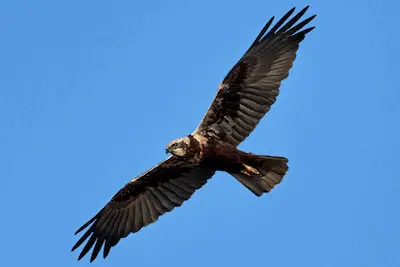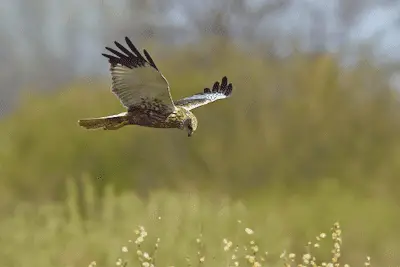Western Marsh Harrier
(Circus aeruginosus)
The Western Marsh Harrier is the largest harrier species in Europe, and at the same time also the most common one.

Especially in central and eastern Europe, Western Marsh Harriers are common wherever there are reed beds big enough for them to breed in.
However, in some parts of western and southern Europe, this bird has declined dramatically due to persecution, and was almost at the point of extinction in the UK.
Fortunately, the Western Marsh Harrier has made an impressive comeback in the UK due to intense conservation efforts, and now breeds with more pairs than for many decades.
This shows that many raptors are capable of surviving, and even thriving, in landscapes intensively shaped by humans if only we give them a chance.
Western Marsh Harrier facts
The Western Marsh Harrier is a large harrier that breeds in reed beds and often hunts in marshy areas, which is how it got its name.
Western Marsh Harrier size
The Western Marsh Harrier is the largest European harrier species, and has a similar wingspan to the European Buzzard.
- Marsh Harrier wingspan: 115-130 cm
- Length: 47-56 cm
- Weight: 550-800 g (female), 400-660 g (male)
But keep in mind that male birds are quite a bit smaller than females, and are thus slightly smaller than a buzzard, though they are still larger than the Hen Harrier (Circus cyaneus), which is the largest harrier species after the Marsh Harrier.
Appearance
The overall appearance of a Western Marsh Harrier is that of a large, dark brown harrier. Adult females and juveniles are uniformly dark brown, while adult males are paler and more colorful, with a rufous brown underside, and pale grey wing and tail feathers, plus black wingtips.

Adult females and juveniles look superficially similar to dark European buzzard species, but are usually easy to distinguish based on their different behavior.
Sexual dimorphism
Similar to the majority of raptors that breed in Europe, female Western Marsh Harriers are generally bigger than males, but there is also quite a big overlap in size between the two sexes.
In addition to the size difference, there is also a difference in color between the sexes: while females are uniformly dark brown with a cream colored patch on the head, males are light brown or rofous, and have pale regions on their wings and tail.
Lifespan
A maximum age of 16 years has been documented in the wild.
Scientific name and taxonomy
The scientific name of the Western Marsh Harrier is Circus aeruginosus. Two subspecies are known, but only one of these occurs in Europe. The other one (C. c. harterti) breeds in northwestern Africa.
Western Marsh Harrier distribution
The Western Marsh Harrier is found throughout most of Europe, except for northern Scandinavia, Iceland, Ireland, and Scotland. While it is present in many southern European countries, its distribution is more patchy here.
Outside of Europe, this bird is found in a broad band that extends eastwards all the way to the Pacific Ocean and Japan.
Western Marsh Harrier habitat
Similar to all harrier species in Europe, this bird prefers open landscapes, including grassland and cultivated farmland. But it is the only harrier in Europe that breeds in reed beds (hence the reason for its name).
Western Marsh Harrier population size
The European population of Western Marsh Harriers is estimated to be between 93,000 and 140,000 breeding pairs by BirdLife International. The largest populations are found in the European part of Russia (up to 60,000 pairs), Ukraine (up to 12,000 pairs), and Belarus (up to 9,000 pairs).
Western Marsh Harrier behavior
The Western Marsh Harrier forages like a typical harrier by flying slowly at low altitude over open ground, and sometimes hovers for a moment or too while it tries to spot suitable prey on the ground below.
Feeding and diet
The largest part of the Western Marsh Harrier’s diet is made up of small rodents, such as voles, but secondarily also young water birds and meadow birds, as well as reptiles and amphibians.
Breeding
Similar to most harriers, the Western Marsh Harrier builds a nest on the ground, which is usually located in tall reed beds, which provide effective protection from most predators, as well as humans.
In areas that have rising populations of this bird, cultivated fields are increasingly chosen as nesting locations, including rape seed oil fields.
The female lays 3-6 eggs, which are incubated for up to 38 days. After hatching, the young harriers stay in the nest for up to 35 days, and continue to be fed for another 2-3 weeks after leaving the nest.
Western March Harrier migration
The Western Marsh Harrier is a partial migrant, with northern, central and eastern European populations being largely migratory, while populations in southern Europe are largely sedentary.
The migratory populations are long-distance migrants that spend their winter in Africa, as well as the Mediterranean area.
Western Marsh Harrier conservation status
While the European population of Western Marsh Harriers underwent a dramatic decline during the last century, this trend has been stabilized, and even reversed in many areas.
For example, this Eurasian raptor species was close to extinction in the UK, but has made an impressive recovery during the past decades, and as a result, the Western Marsh Harrier now breeds in the UK with 400 pairs according to the RSPB.
Threats
The biggest threat to the Marsh Harrier is destruction of habitat due to draining of wetlands and conversion to farmland. This should be avoided wherever possible, or if not, some marginal areas should be preserved as nesting grounds for this raptor.
Also, in areas where Marsh Harriers have started nesting in cultivated fields, the area with the nest must be protected from harvesting machines (while compensating the farmers).
After habitat loss, the second biggest threat to Western Marsh Harriers is illegal shooting, which is unfortunately still common during migration, and needs to be strictly prohibited.
Finally, wind farms are another threat that cause lethal collisions with this bird of prey, and this issue needs to be closely monitored and mitigated.
Additional resources:
- Montagu’s Harrier conservation status
- Pallid Harrier feeding and diet
- Levant Sparrowhawk population size
